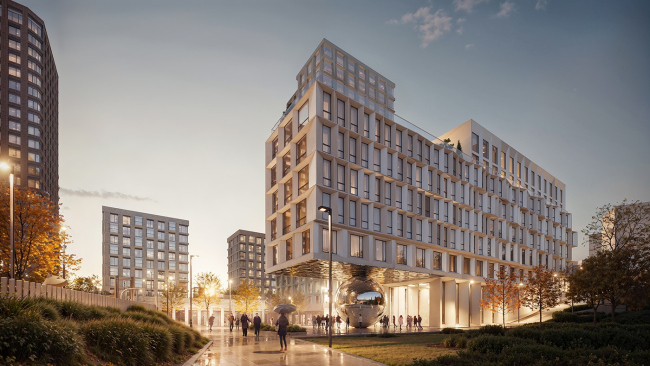|
Published on Archi.ru (https://archi.ru) |
|
| 01.07.2024 | |
|
Above the Golden Horn |
|
|
Julia Tarabarina |
|
| Architect: | |
| Sergey Trukhanov | |
| Studio: | |
| ̉+̉ Architects | |
|
The residential complex “Philosophy” designed by T+T architects in Vladivostok, is one of the new projects in the “Golubinaya Pad” area, changing its development philosophy (pun intended) from single houses to a comprehensive approach. The buildings are organized along public streets, varying in height and format, with one house even executed in gallery typology, featuring a cantilever leaning on an art object. Vladivostok is undergoing intense construction and renewal, and the “Philosophy” residential complex is not Sergey Trukhanov’s first project in this city. It is also not the first experience for T+T Architects in creating a comfortable urban environment on challenging terrain, adhering to all architectural and urban planning parameters, ranging from small scale (boulevard and landscaping, shops on the ground floor, and art objects in pedestrian spaces) to large scale (silhouette, varying heights, choreography of pauses, balance between dominants and small volumes, coherence and discreteness, diversity of facades). “Philosophy” residential complexCopyright: © ̉+̉ ArchitectsThe project also considers views that open up from the highway: designed to enhance views and gradually increase massing, the complex is structured with lower volumes facing the bay and taller towers in the northern part. It lays out its plans akin to a Japanese painting and presents itself to the city as a composition of verticals and horizontals, walls, and towers. All the buildings here are distinct. Two towers, 23 and 26 stories high – a dark terracotta tower and an almost white one – are positioned at key corners like two rocks from a well-known ancient myth. The white tower, taller and closer to modernist prototypes, features its upper part articulated with large terraced steps. In contrast, the terracotta tower, leaning more towards allusions from red-brick industry buildings, is more dynamic due to its brick balconies on the lower part and thanks to the consistent optical “folding” of corners in its upper part.  “Philosophy” residential complexCopyright: © ̉+̉ Architects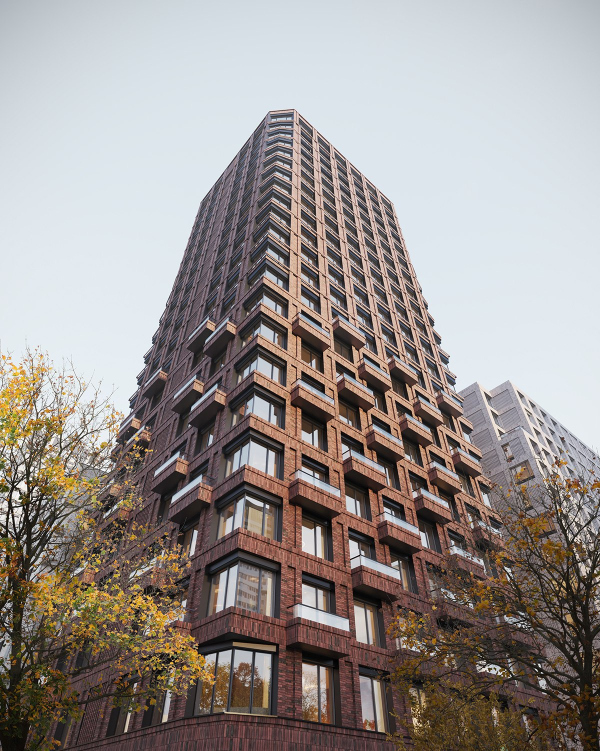 “Philosophy” residential complexCopyright: © ̉+̉ ArchitectsThese two dominant towers set the main themes: white and terracotta. Between them stand 10-story tower-like buildings, currently referred to as “urban villas”, although the format resembles nine-story buildings from the 1970s – and why not? They have found answers to so many questions. These smaller towers perform a color “rook move” and hold the northern edge. They act as propylaea, with a pylon-like entrance gate (a very classical solution) between them. Adjacent to them, on the sides, entrances lead to underground parking, following their rhythm. 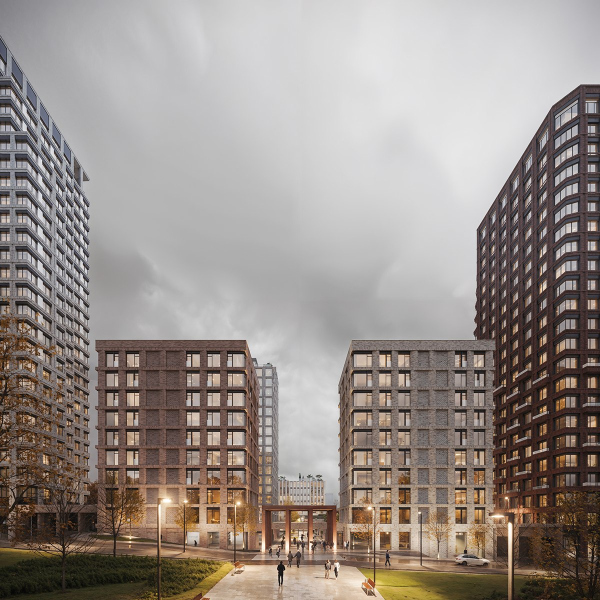 “Philosophy” residential complexCopyright: © ̉+̉ Architects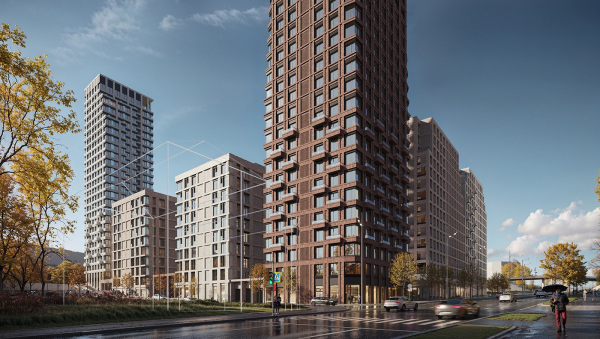 “Philosophy” residential complexCopyright: © ̉+̉ ArchitectsAdditionally, adjacent to the terracotta tower is a two-section plate of cascading form, featuring regular “cutouts” of terraces at the corners and at the junction, with a plate-like end and a pyramidal-stepped contour of the entrance lobby.  “Philosophy” residential complexCopyright: © ̉+̉ Architects “Philosophy” residential complexCopyright: © ̉+̉ ArchitectsThis slab completes the complex from the east, giving the entire composition the character of a block, not fully enclosed, but still a block, and protects against wind blowing from the mountains. The third theme concerns the central tower and the southern 5-7 story building. Their facades are no longer brick but metallic and faceted – in the overall context, they are the flashiest ones. There is no doubt that, although the tall dominants are more noticeable from a distance and define the overall ensemble like two poles, these silvery buildings are visually more important and valuable. But that’s not everything. The southern building not only opens views to the bay for its neighbors thanks to its slightly lower height – it also has a gallery typology. “Philosophy” residential complexCopyright: © ̉+̉ ArchitectsOver the past 20 years, in capital cities, many heated debates have been sparked about the possibility or impossibility of typological explorations within the framework of modern residential complexes rigidly defined by marketers. It seemed that the searches had stalled, leading to the discouraging conclusion of the optimality of towers and ordinary section buildings. But no, these discussions, as it appears, haven’t died down; they’re ongoing. Here’s a gallery house for you. Yes, in Vladivostok. Even more intriguing is a large cantilever with a polished surface and a shiny metal sphere as its support – an art object, but not just any art object; it’s seamlessly integrated into the architectural solution and functions as a practical support. Undoubtedly, a noticeable accent. “Philosophy” residential complexCopyright: © ̉+̉ ArchitectsThe sphere support and northern propylaea present the complex to the city, not just as a silhouette or composition of volumes, but directly as a new part of it. The plot is trapezoidal, almost square. It includes a public easement, T-shaped in plan, stretching along the central axis from west to east, plus an extension northward. Just in case: a public easement means that the land belongs to the owner, but their rights are restricted by law [Art. 23 of the Civil Code of the Russian Federation], and this area cannot be closed for public use. Thus, within the complex and considering the plot’s limitations, two interconnected urban streets are formed – an open space that, as known, enhances modern residential complexes, attracting buyers to shops and cafes. 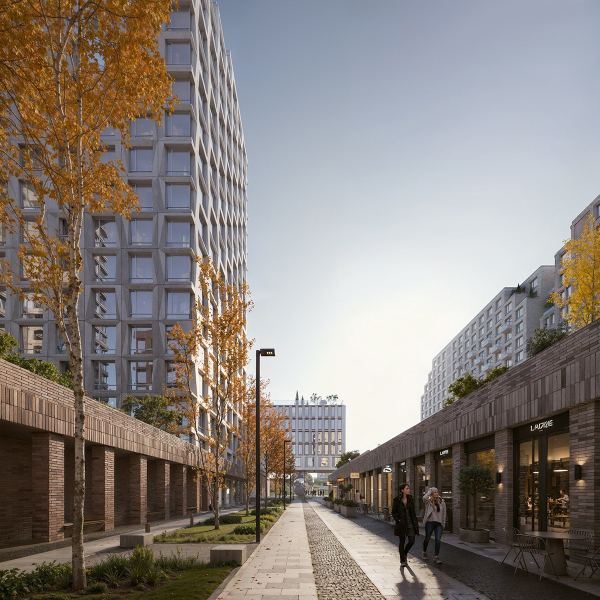 “Philosophy” residential complexCopyright: © ̉+̉ Architects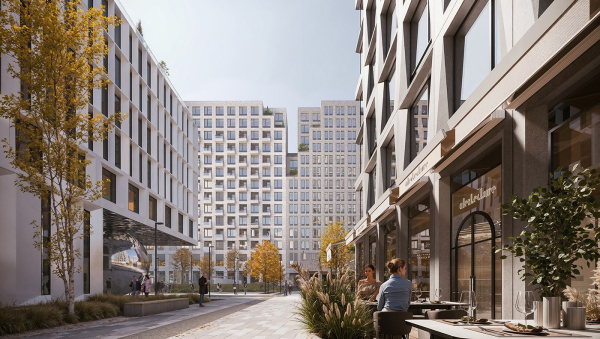 “Philosophy” residential complexCopyright: © ̉+̉ ArchitectsAt the same time, as we all remember, Vladivostok is a city of hills or even mountains, and the height difference on the plot is not radical by the standards of this city, being mere 10 meters. The architects use it to organize the complex’s interior space, primarily for gracefully separating public and private areas. Courtyards appear on stylobates, and in one place, they are connected by a bridge over the public street—a modern variation of the “metropolitan” approach to separating flows within a residential complex, especially since such an approach has been used in Moscow already more than once, making it a contemporary trend. ***
The FSK Group promises to complete the construction of the first phase of the complex, which includes a kindergarten, by the third quarter of 2026. |
|

